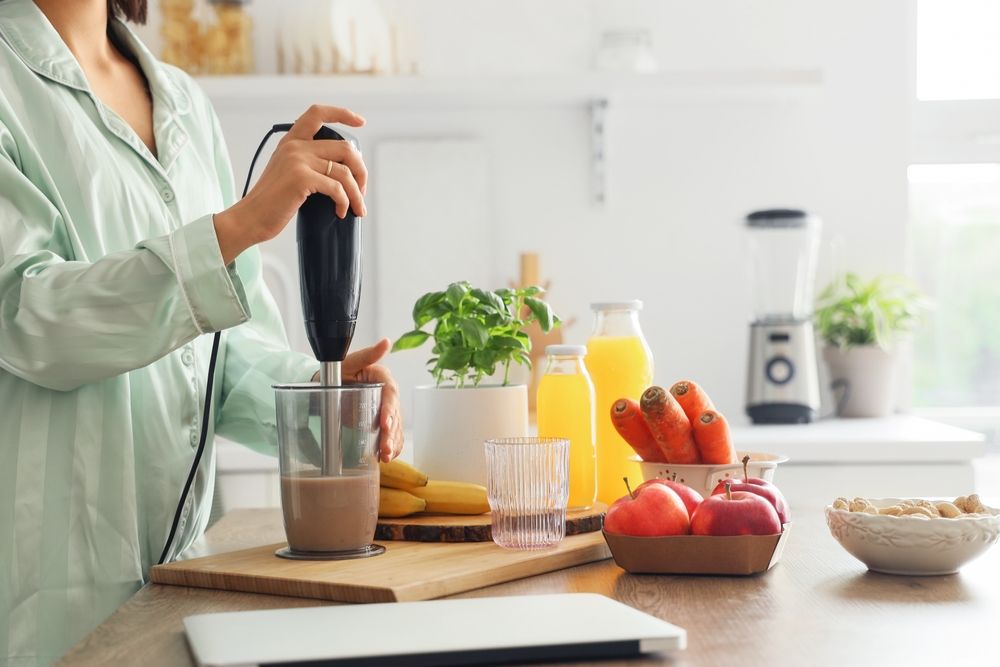When it comes to fast, mess-free blending, hand blenders — also known as immersion blenders or stick blenders — are a home cook’s best friend. Whether you’re whipping up smoothies, puréeing soup right in the pot, or making fresh homemade sauces, a quality hand blender saves time, space, and cleanup.
But not all hand blenders are created equal. From power levels to attachments and ergonomic design, the right features can make a big difference in performance and versatility. This guide will help you understand what to look for and highlight the best types of hand blenders for everyday kitchen use.
1. Why Choose a Hand Blender?
A hand blender offers unique benefits compared to traditional countertop blenders or food processors.
Advantages of Hand Blenders:
-
Compact and lightweight: Easy to store and handle.
-
Minimal cleanup: Blend directly in the pot, cup, or bowl.
-
Versatile: Great for soups, sauces, baby food, whipped cream, and smoothies.
-
Affordable: Typically less expensive than larger appliances.
-
Quick use: Ideal for small batches and one-person meals.
If you regularly cook at home or want a powerful tool for quick tasks, a hand blender is an essential upgrade.
2. What to Look For in a Hand Blender
With so many models on the market, choosing the right one means focusing on your cooking style and desired features.
Key Buying Considerations:
Power and Speed
-
Measured in watts (W); common models range from 200W to 1000W.
-
For thick mixtures (like nut butter or frozen fruits), aim for 500W or more.
-
Multiple speed settings and turbo functions give you better control.
Blending Shaft Material
-
Stainless steel shafts are more durable and heat-resistant — great for hot soups.
-
Plastic shafts are lighter but may stain or warp over time.
Blade Design
-
Look for multi-pronged or cross-style blades that reduce splatter and offer smoother blends.
-
Some high-end models include anti-suction blade guards for better food flow.
Ease of Cleaning
-
Detachable shafts and dishwasher-safe parts are a big plus.
-
Avoid models with fixed blades that are hard to rinse thoroughly.
Ergonomics and Grip
-
A comfortable, non-slip handle reduces fatigue during longer tasks.
-
Lightweight designs are easier to maneuver, especially in deep pots.
3. Common Attachments and Accessories
Many hand blenders come with added tools that expand their functionality.
Popular Attachments:
-
Whisk: For whipped cream, egg whites, or batters.
-
Chopper or mini food processor: Great for nuts, herbs, and onions.
-
Beaker or mixing cup: Perfectly sized for blending smoothies or shakes.
-
Masher attachment: For soft vegetables or potatoes.
If you want an all-in-one tool, look for models with multiple attachments. Otherwise, a basic blending-only model may suffice for simple needs.
4. Corded vs. Cordless Hand Blenders
Cordless models are gaining popularity for their portability and convenience, but each option has its pros and cons.
Corded Hand Blenders:
-
Provide consistent power output.
-
Best for long blending tasks or dense mixtures.
-
Typically lighter and less expensive.
Cordless Hand Blenders:
-
Offer freedom of movement — great for busy or small kitchens.
-
Need charging between uses.
-
Slightly bulkier due to the battery pack.
If you do lots of outdoor cooking or want to blend anywhere, a cordless model may be worth the investment.
5. Top Use Cases for Hand Blenders
1. Soups and Sauces
-
Blend hot soups directly in the pot — no need to transfer.
-
Create creamy tomato soup or butternut squash purée with less mess.
2. Smoothies and Protein Shakes
-
Quick breakfast shakes in a single cup.
-
Ideal for solo servings or post-workout blends.
3. Baby Food
-
Easily purée steamed fruits or vegetables.
-
Control texture for different stages of feeding.
4. Whipped Cream and Mayonnaise
-
Make fresh whipped cream in minutes.
-
Emulsify homemade mayo with precision and speed.
5. Pancake or Batter Mixing
-
Blend small batches directly in a mixing bowl or cup.
-
Reduce clumps and improve consistency.
6. Maintenance and Safety Tips
A well-maintained hand blender will last for years and provide consistently great results.
Cleaning Tips:
-
Detach and rinse the shaft immediately after use.
-
For tougher messes, blend a cup of soapy water for fast cleaning.
-
Dry thoroughly to prevent rust or mold in the blades.
Safety Tips:
-
Never submerge the motor handle in water.
-
Avoid operating the blender in a pot on a hot stove — remove from heat first.
-
Keep fingers and utensils away from the blades when the unit is plugged in.
Treat your hand blender like any other kitchen tool — with care and caution — to get the best performance over time.
7. Recommended Wattage for Tasks
Choosing the right power level ensures better blending and durability over time.
| Task | Recommended Wattage |
|---|---|
| Smoothies / Ice | 600W+ |
| Soups / Sauces | 400–600W |
| Whipping cream | 300–500W |
| Baby food / Soft fruits | 200–300W |
Going with a slightly more powerful motor can give your blender a longer life and better results across a wider range of tasks.
8. Brands to Consider
Some brands stand out for performance, durability, and customer satisfaction.
Popular and Reliable Options:
-
Breville: Powerful motors and premium design
-
KitchenAid: Stylish and well-built with great accessories
-
Braun: Known for powerful, consistent blending
-
Cuisinart: Affordable models with good accessory kits
-
Hamilton Beach: Budget-friendly and reliable
Check reviews, warranty terms, and replacement part availability when choosing a brand — especially if you plan to use your hand blender frequently.
9. Setting a Realistic Budget
Hand blenders range in price from entry-level models to professional-grade tools.
Budget Guide:
-
$20–$40: Basic models, good for occasional blending.
-
$40–$80: Mid-range with attachments and higher power.
-
$80–$150+: High-end, multi-use systems with advanced features.
Choose based on your usage — light users can go with simple models, while everyday cooks may benefit from investing in premium quality.
10. Final Tips for Buying the Best Hand Blender
-
Think about storage space. Slim, wall-mountable, or drawer-safe models are great for small kitchens.
-
Check the noise level. Some models are quieter, especially in the high-end range.
-
Review warranty details. A 1- or 2-year warranty is standard, but some brands offer extended protection.
If possible, test the grip and weight before purchasing. The best blender is one that feels good in your hand, works with your preferred cookware, and handles your everyday kitchen tasks with ease.





